Experimental Study of Large-Temperature-Range and Long-Period Monitoring for LNG Marine Auxiliary Based on Fiber Bragg Grating Temperature Measurement
Abstract
1. Introduction
2. Principle and Trial-Production of FBG Temperature Sensor
3. Experimental Measurements of Marine Auxiliaries
3.1. Temperature Measurement of LNG Tank
3.2. Temperature Measurement of Chiller and Pipeline System
4. Results and Discussions
4.1. Influence of Sensor Packaging Materials
4.2. Measurement Accuracy, Stability and Response in Cryogenic Conditions
4.3. Temperature Monitoring of Marine Chiller System
5. Conclusions
- (1)
- The Bragg grating wavelengths of the three metal coatings were obtained in a large temperature range. The corresponding values of copper, gold, and zinc coatings are 1540–1538, 1550–1548, and 1555–1553 nm, respectively. The gold-plated Bragg grating had the largest wavelength deviation in the overall testing range, the deviation of copper coating layer would greatly increase in the low temperature area, and the zinc coating layer had the smallest deviation in the low temperature area;
- (2)
- In the low-temperature measurements of LNG storage tank, the FBG sensor with the explosion-proof, non-electric-spark, and pure optical fiber transmission performed an excellent accuracy and stability. The measurement error was only −0.01 to 0.03 K, and the dynamic response is faster than the traditional RTD sensors. It proves that the proposed FBG sensor can effectively measure the temperature stratification to meet the status monitoring of the LNG storage tank;
- (3)
- For the temperature monitoring of marine chiller system, the drift degrees of the two types of temperature sensors (RTD and FBG) were compared and analyzed in the long-term reliability experiment. It indicated that the non-waterproof FBG installed on the open thermowell can provide the best temperature accuracy and stability when the temperature sensor is inserted at the distance of 8D from the water mixing point of the pipe. Since the sub-pipes were mixed to the main straight pipe by elbows, the errors of both RTD and FBG installed on the elbow would greatly fluctuate due to the vibrations after the turbulent flow.
Author Contributions
Funding
Institutional Review Board Statement
Informed Consent Statement
Acknowledgments
Conflicts of Interest
References
- Sui, C.; de Vos, P.; Stapersma, D.; Visser, K.; Ding, Y. Fuel Consumption and Emissions of Ocean-Going Cargo Ship with Hybrid Propulsion and Different Fuels over Voyage. J. Mar. Sci. Eng. 2020, 8, 588. [Google Scholar] [CrossRef]
- Nuchturee, C.; Li, T.; Xia, H. Energy efficiency of integrated electric propulsion for ships—A review. Renew. Sustain. Energy Rev. 2020, 134, 110145. [Google Scholar] [CrossRef]
- Poljak, I.; Bielić, T.; Mrzljak, V.; Orović, J. Analysis and Optimization of Atmospheric Drain Tank of Lng Carrier Steam Power Plant. J. Mar. Sci. Eng. 2020, 8, 568. [Google Scholar] [CrossRef]
- Han, F.; Wang, Z.; Jiang, Y.; Ji, Y.; Li, W. Energy assessment and external circulation design for LNG cold energy air separation process under four different pressure matching schemes. Case Stud. Therm. Eng. 2021, 27, 101251. [Google Scholar] [CrossRef]
- Altosole, M.; Campora, U.; Donnarumma, S.; Zaccone, R. Simulation Techniques for Design and Control of a Waste Heat Recovery System in Marine Natural Gas Propulsion Applications. J. Mar. Sci. Eng. 2019, 7, 397. [Google Scholar] [CrossRef]
- Wang, Z.; Han, F.; Ji, Y.; Li, W. Analysis on feasibility of a novel cryogenic heat exchange network with liquid nitrogen regeneration process for onboard liquefied natural gas reliquefaction. Case Stud. Therm. Eng. 2020, 22, 100760. [Google Scholar] [CrossRef]
- Hwang, S.; Jeong, B.; Jung, K.; Kim, M.; Zhou, P. Life Cycle Assessment of LNG Fueled Vessel in Domestic Services. J. Mar. Sci. Eng. 2019, 7, 359. [Google Scholar] [CrossRef]
- Wang, Z.; Han, F.; Liu, Y.; Li, W. Evolution Process of Liquefied Natural Gas from Stratification to Rollover in Tanks of Coastal Engineering with the Influence of Baffle Structure. J. Mar. Sci. Eng. 2021, 9, 95. [Google Scholar] [CrossRef]
- Wang, Z.; Han, F.; Ji, Y.; Li, W. Redundant energy combination and recovery scheme for dual fuel carriers based on thermo-electric harvesting with a large temperature range. Int. J. Energy Res. 2021, 45, 7404–7420. [Google Scholar] [CrossRef]
- Han, F.; Ong, M.C.; Xing, Y.; Li, W. Three-dimensional numerical investigation of laminar flow in blind-tee pipes. Ocean Eng. 2020, 217, 107962. [Google Scholar] [CrossRef]
- Pinault, J.-L. Modulated Response of Subtropical Gyres: Positive Feedback Loop, Subharmonic Modes, Resonant Solar and Orbital Forcing. J. Mar. Sci. Eng. 2018, 6, 107. [Google Scholar] [CrossRef]
- Sekhar, C.; Zheng, L. Study of an integrated personalized ventilation and local fan-induced active chilled beam air conditioning system in hot and humid climate. In Building Simulation; Tsinghua University Press: Beijing, China, 2018; Volume 11, pp. 787–801. [Google Scholar]
- Venkataraman, V.; El-Kharouf, A.; Pandya, B.; Amakiri, E.; Steinberger-Wilckens, R. Coupling of engine exhaust and fuel cell exhaust with vapour absorption refrigeration/air conditioning systems for transport applications: A review. Thermal. Sci. Eng. Prog. 2020, 18, 100550. [Google Scholar] [CrossRef]
- Zhani, K.; Ali Abuhasel, K. Modeling, Simulation, and Optimization of a Solar-Based System of Desalination Using Humidification and Dehumidification. Appl. Sci. 2020, 10, 3361. [Google Scholar] [CrossRef]
- Barone, G.; Buonomano, A.; Forzano, C.; Palombo, A.; Vicidomini, M. Sustainable energy design of cruise ships through dynamic simulations: Multi-objective optimization for waste heat recovery. Energy Convers. Manag. 2020, 221, 113166. [Google Scholar] [CrossRef]
- Sapronov, O.; Maruschak, P.; Sotsenko, V.; Buketova, N.; De Deus, A.B.D.G.; Sapronova, A.; Prentkovskis, O. Development and Use of New Polymer Adhesives for the Restoration of Marine Equipment Units. J. Mar. Sci. Eng. 2020, 8, 527. [Google Scholar] [CrossRef]
- Wang, Z.; Cai, W.; Han, F.; Ji, Y.; Li, W.; Sundén, B. Feasibility study on a novel heat exchanger network for cryogenic liquid regasification with cooling capacity recovery: Theoretical and experimental assessments. Energy 2019, 181, 771–781. [Google Scholar] [CrossRef]
- Han, F.; Wang, Z.; Ji, Y.; Li, W.; Sundén, B. Energy analysis and multi-objective optimization of waste heat and cold energy recovery process in LNG-fueled vessels based on a triple organic Rankine cycle. Energy Convers. Manag. 2019, 195, 561–572. [Google Scholar] [CrossRef]
- Wood, D.A. Predicting saturated vapor pressure of LNG from density and temperature data with a view to improving tank pressure management. Petroleum 2021, 7, 91–101. [Google Scholar] [CrossRef]
- Wang, H.; Xiang, P.; Jiang, L. Strain transfer theory of industrialized optical fiber-based sensors in civil engineering: A review on measurement accuracy, design and calibration. Sens. Actuators A Phys. 2019, 285, 414–426. [Google Scholar] [CrossRef]
- Deng, J. Real-time navigation monitoring system research for LNG-fuelled ship in inland water. J. Marit. Res. 2015, 12, 95–102. [Google Scholar]
- Zhao, L.; Zhang, G.W.; Zhang, Q.; Zhang, Y.K. Multi-Point Temperature Monitoring System for the LNG Storage Tank. Appl. Mech. Mater. 2014, 511–512, 282–285. [Google Scholar] [CrossRef]
- Aneziris, O.; Koromila, I.; Nivolianitou, Z. A systematic literature review on LNG safety at ports. Saf. Sci. 2020, 124, 104595. [Google Scholar] [CrossRef]
- Oh, D.J.; Kim, N.K.; Song, S.W.; Kim, Y.D.; Kim, M.H. Investigation of fatigue performance for new membrane-type LNG CCS at cryo-genic temperature. Mar. Struct. 2018, 62, 90–105. [Google Scholar] [CrossRef]
- Chen, C.; Wu, Q.; Xiong, K.; Zhai, H.; Yoshikawa, N.; Wang, R. Hybrid Temperature and Stress Monitoring of Woven Fabric Thermoplastic Composite Using Fiber Bragg Grating Based Sensing Technique. Sensors 2020, 20, 3081. [Google Scholar] [CrossRef] [PubMed]
- Seema, R.; Mandal, S.; Singh, P.; Paul, S.; Chanda, N. Fiber Bragg grating sensors for in-situ temperature measurement on bending a flexible planar supercapacitor. Sens. Actuators A Phys. 2020, 314, 112266. [Google Scholar] [CrossRef]
- Bakaic, M.; Hanna, M.; Hnatovsky, C.; Grobnic, D.; Mihailov, S.; Zeisler, S.S.; Hoehr, C. Fiber-Optic Bragg Gratings for Temperature and Pressure Measurements in Isotope Production Targets for Nuclear Medicine. Appl. Sci. 2020, 10, 4610. [Google Scholar] [CrossRef]
- Pang, B.; Gu, Z.; Ling, Q.; Wu, W.; Zhou, Y. Simultaneous measurement of temperature and surrounding refractive index by superimposed coated long period fiber grating and fiber Bragg grating sensor based on mode barrier region. Optik 2020, 220, 165136. [Google Scholar] [CrossRef]
- Dutz, F.J.; Heinrich, A.; Bank, R.; Koch, A.W.; Roths, J. Fiber-Optic Multipoint Sensor System with Low Drift for the Long-Term Monitoring of High-Temperature Distributions in Chemical Reactors. Sensors 2019, 19, 5476. [Google Scholar] [CrossRef] [PubMed]
- Yu, F.; Saito, O.; Okabe, Y. An ultrasonic visualization system using a fiber-optic Bragg grating sensor and its application to damage detection at a temperature of 1000 °C. Mech. Syst. Signal Process. 2021, 147, 107140. [Google Scholar] [CrossRef]
- Zheng, Y.; Bremer, K.; Roth, B. Investigating the Strain, Temperature and Humidity Sensitivity of a Multimode Graded-Index Perfluorinated Polymer Optical Fiber with Bragg Grating. Sensors 2018, 18, 1436. [Google Scholar] [CrossRef]
- Thekkethil, S.; Roy, K.R.; Thomas, R.; Neumann, H.; Ramalingam, R. Mathematical Model for a Novel Cryogenic Flow Sensor Using Fibre Bragg Gratings. Procedia Technol. 2016, 24, 477–484. [Google Scholar] [CrossRef][Green Version]
- Li, L.; Lv, D.; Yang, M.; Xiong, L.; Luo, J.; Tan, L. Strain characteristics of the silica-based fiber Bragg gratings for 30–273 K. Cryogenics 2018, 92, 93–97. [Google Scholar] [CrossRef]
- Vendittozzi, C.; Felli, F.; Lupi, C. Modeling FBG sensors sensitivity from cryogenic temperatures to room temperature as a function of metal coating thickness. Opt. Fiber Technol. 2018, 42, 84–91. [Google Scholar] [CrossRef]
- Li, Y.; Yang, K.; Li, X. Temperature sensing characteristics of metal coated FBG during dynamic cooling process. Opt. Fiber Technol. 2018, 45, 368–375. [Google Scholar] [CrossRef]

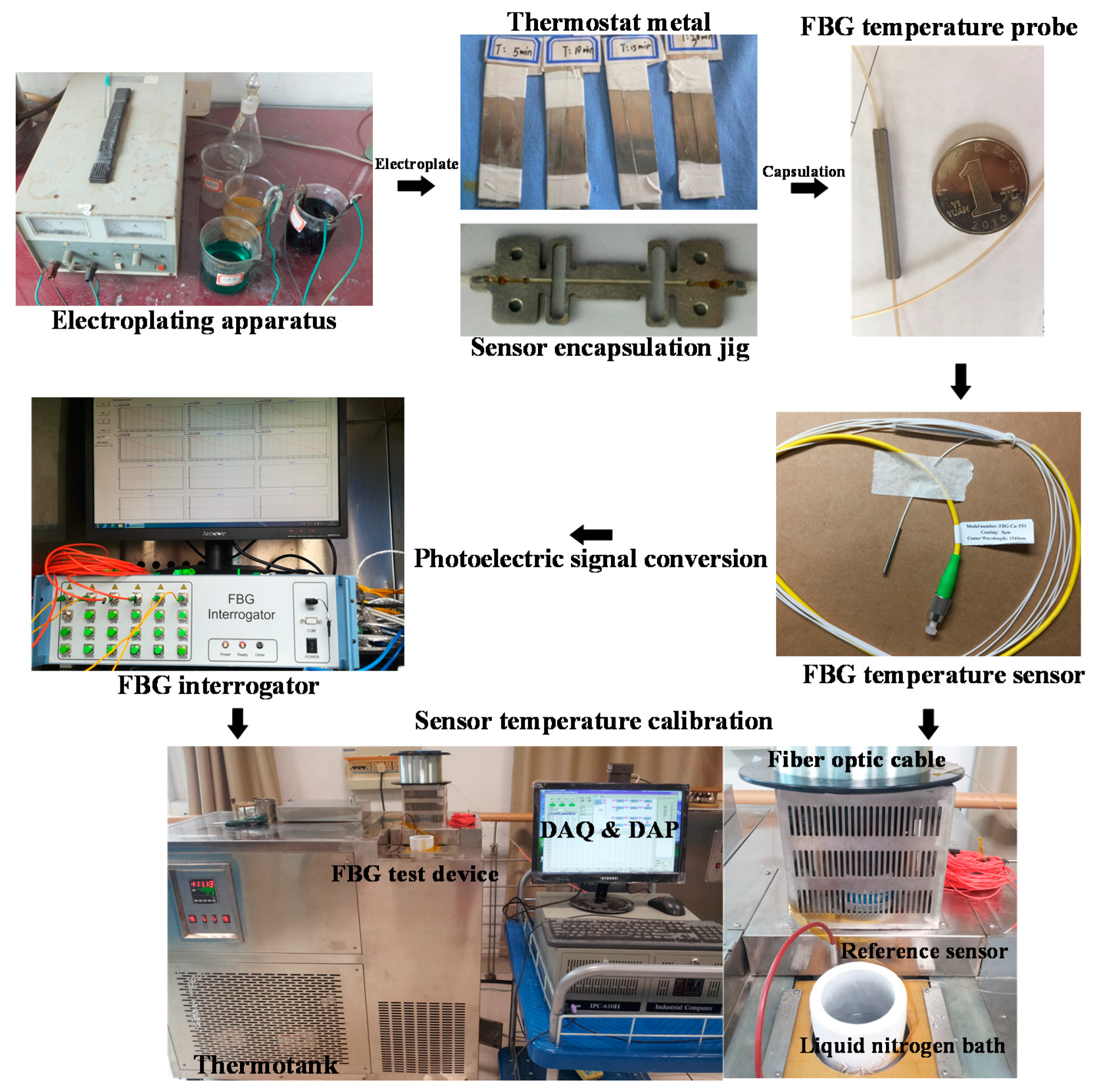
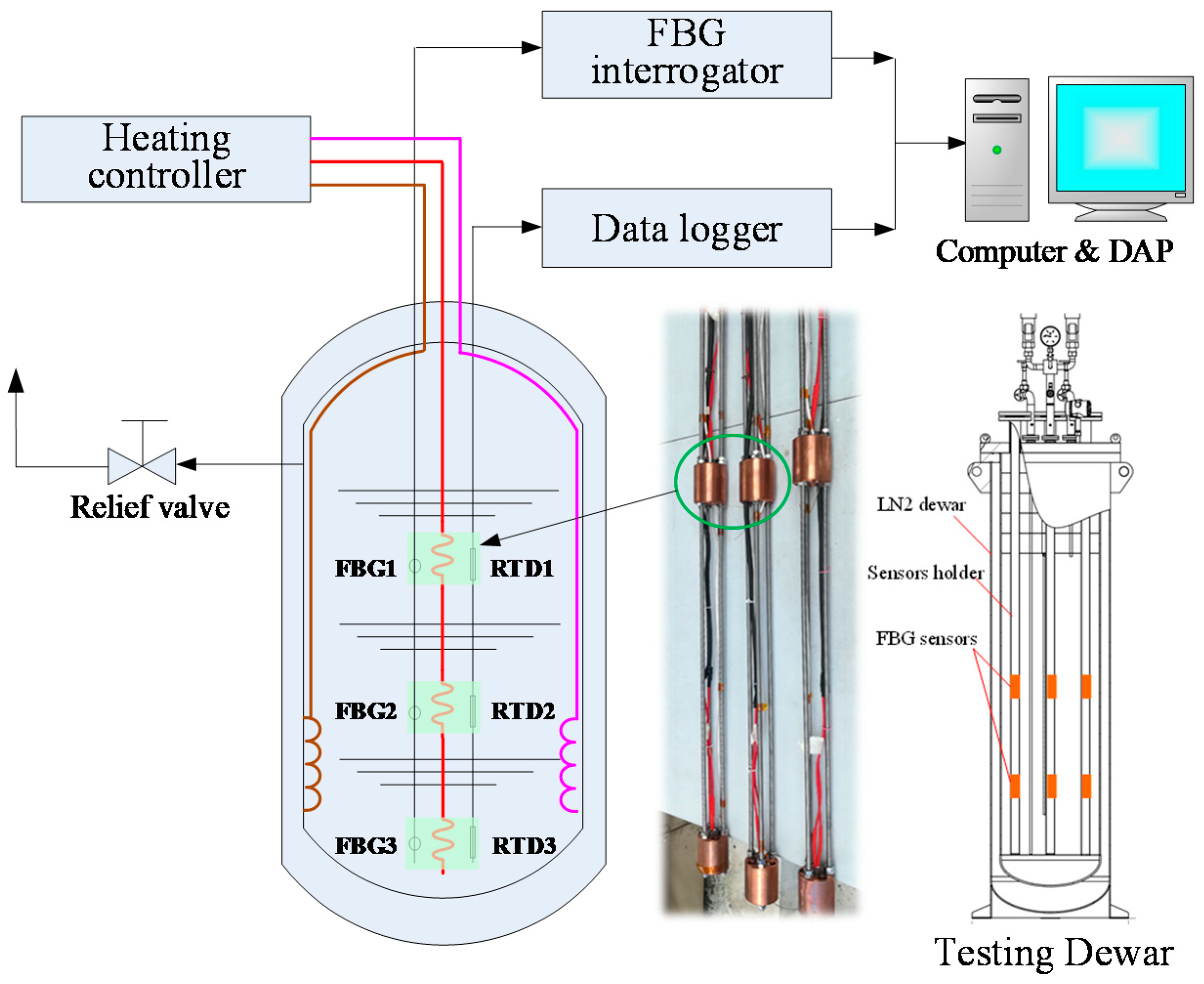

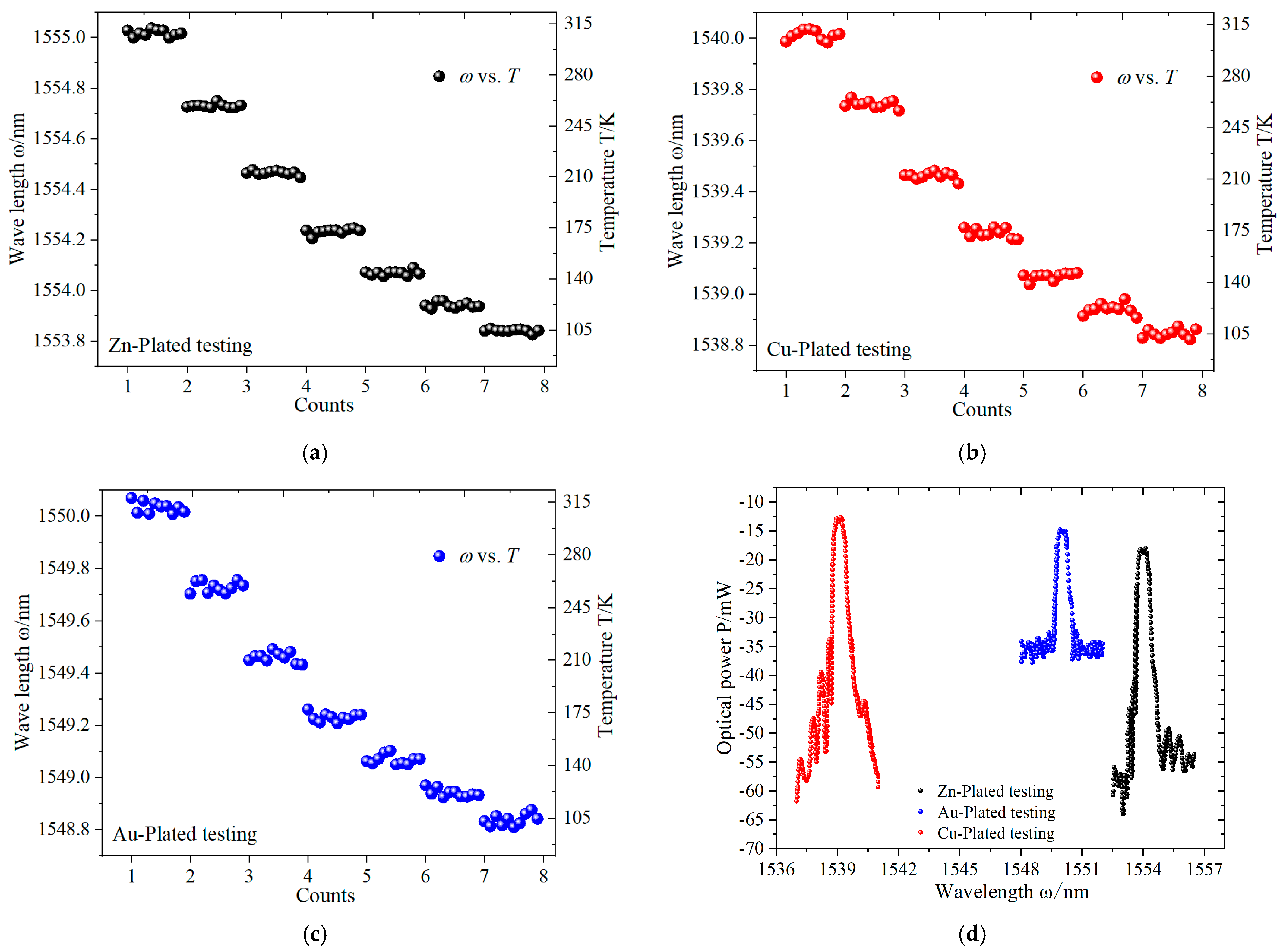
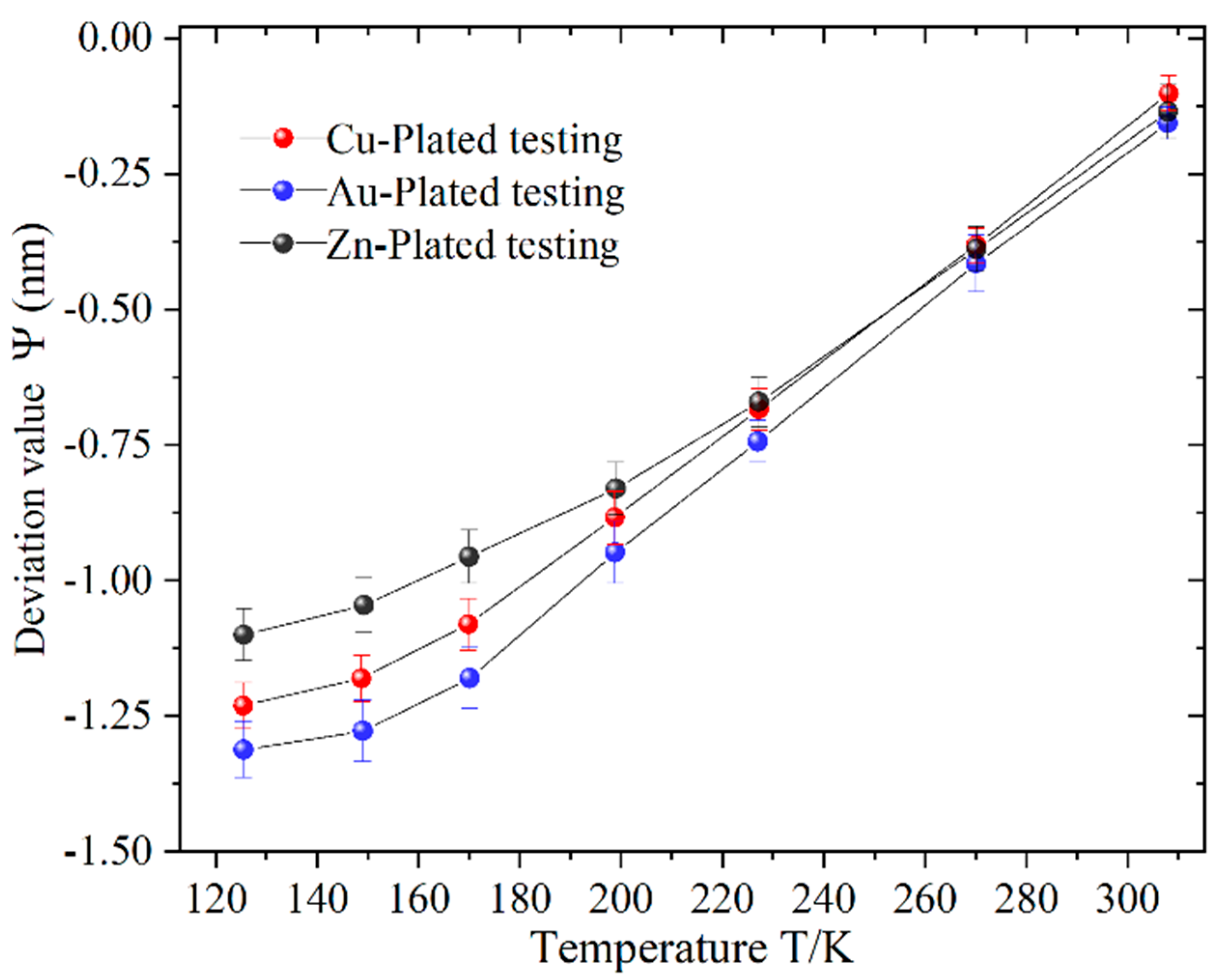
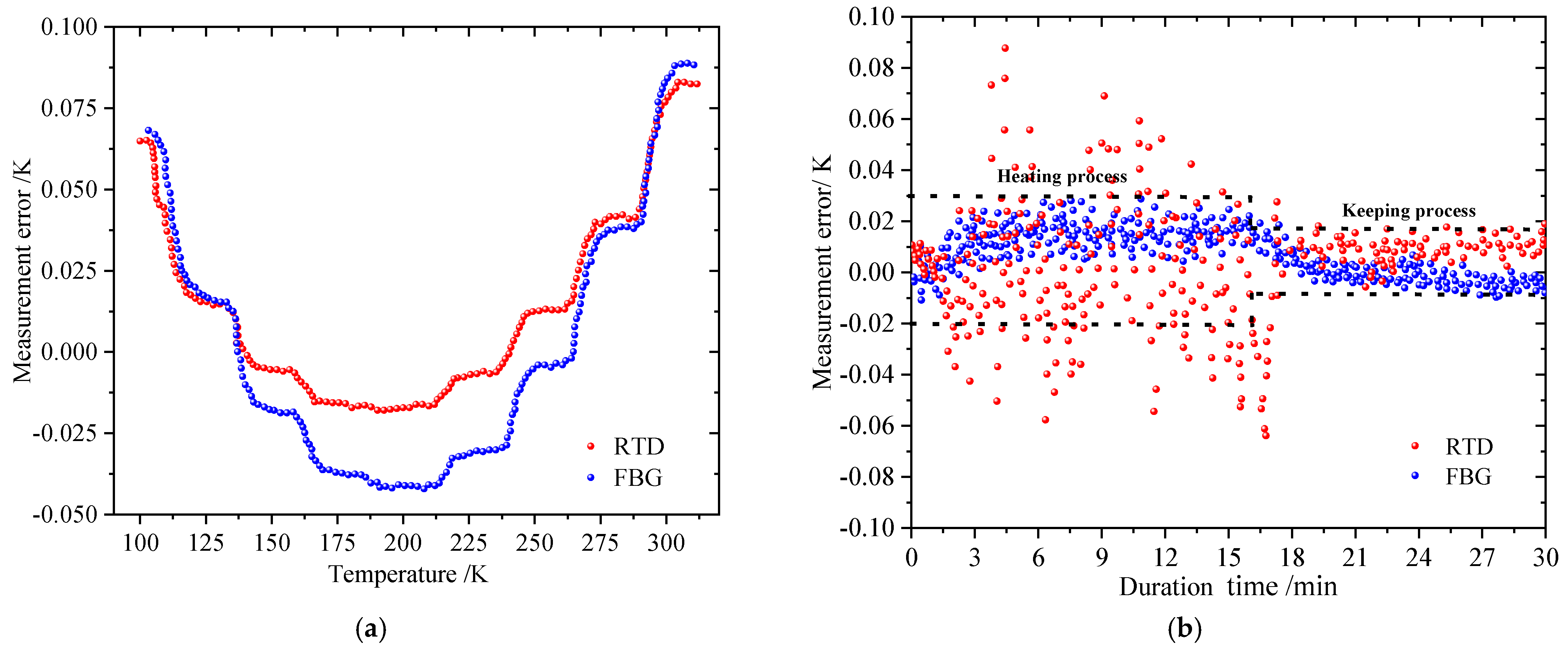
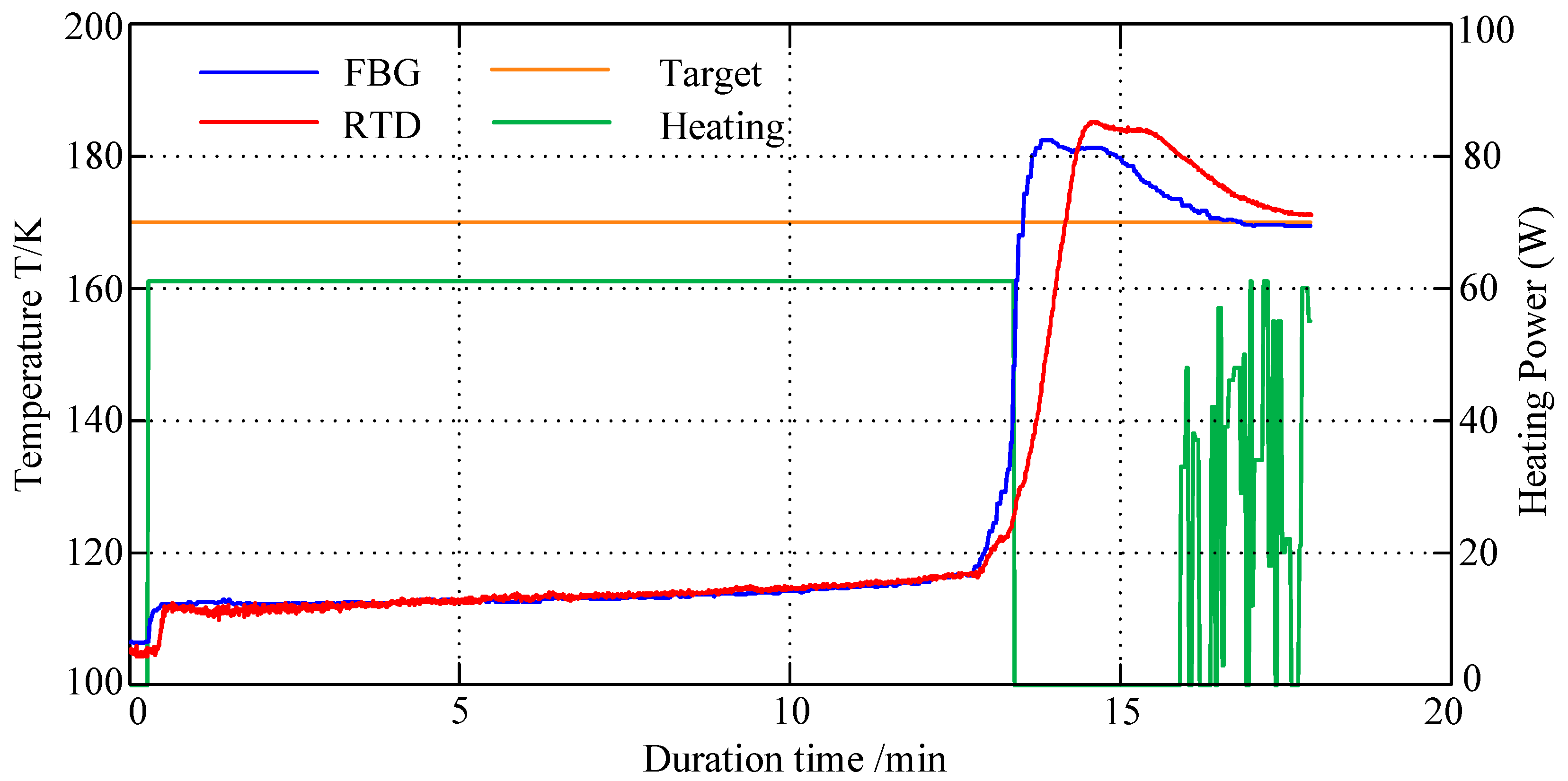
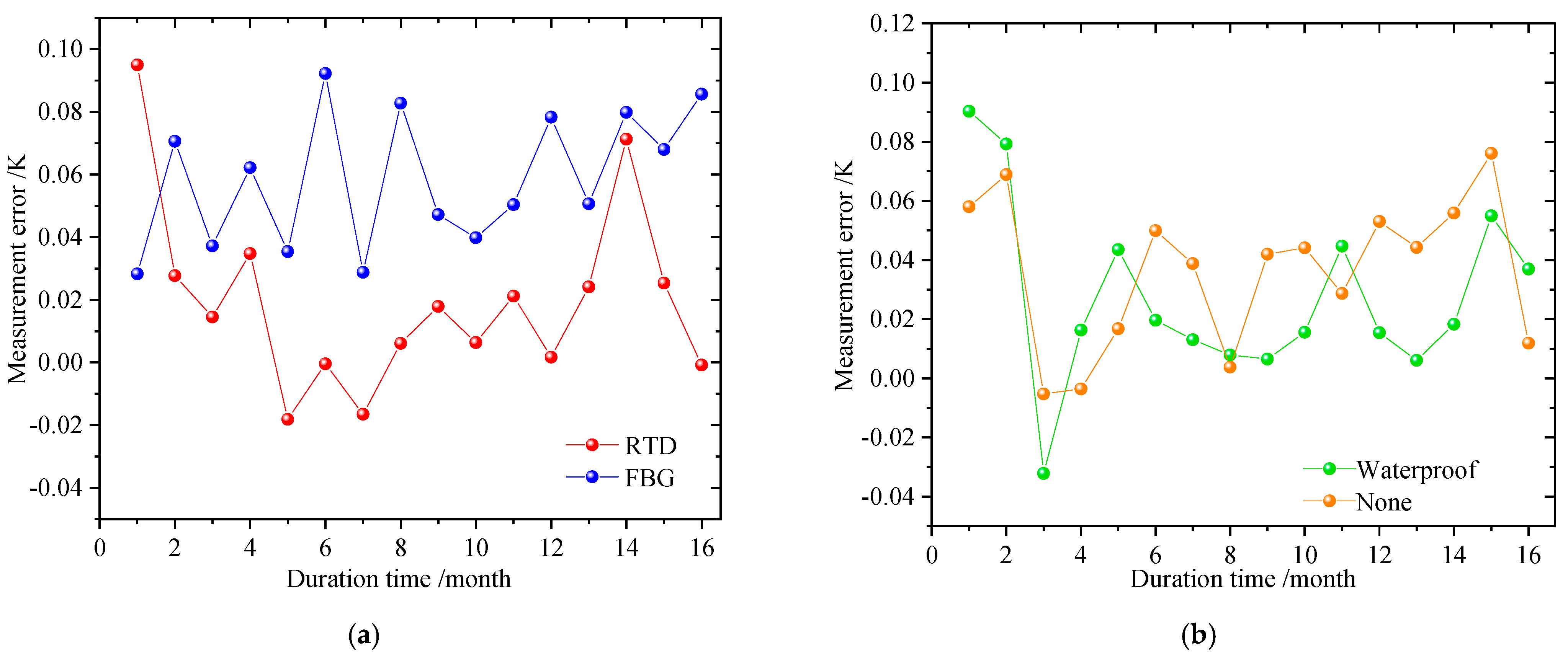
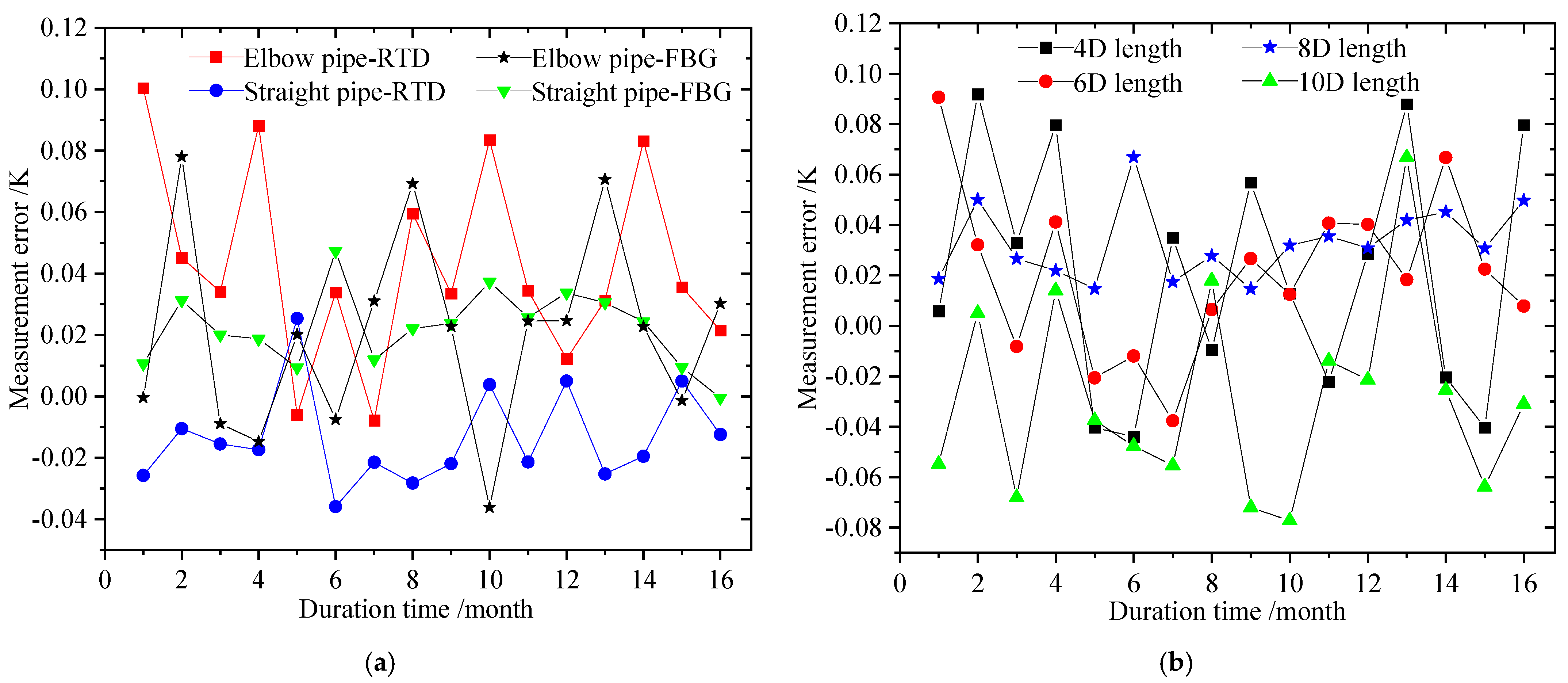
| Insertion Length (mm) | Standard Deviation of the Error (K) | Insertion Depth/Pipe Diameter |
|---|---|---|
| 20 | 0.589006937 | 0.425 |
| 50 | 0.21651205 | 0.475 |
| 80 | 0.018468919 | 0.525 |
| 110 | 0.055356604 | 0.575 |
| 140 | 0.079622758 | 0.625 |
Publisher’s Note: MDPI stays neutral with regard to jurisdictional claims in published maps and institutional affiliations. |
© 2021 by the authors. Licensee MDPI, Basel, Switzerland. This article is an open access article distributed under the terms and conditions of the Creative Commons Attribution (CC BY) license (https://creativecommons.org/licenses/by/4.0/).
Share and Cite
Han, F.; Wang, Z.; Zhang, H.; Wang, D.; Li, W.; Cai, W. Experimental Study of Large-Temperature-Range and Long-Period Monitoring for LNG Marine Auxiliary Based on Fiber Bragg Grating Temperature Measurement. J. Mar. Sci. Eng. 2021, 9, 917. https://doi.org/10.3390/jmse9090917
Han F, Wang Z, Zhang H, Wang D, Li W, Cai W. Experimental Study of Large-Temperature-Range and Long-Period Monitoring for LNG Marine Auxiliary Based on Fiber Bragg Grating Temperature Measurement. Journal of Marine Science and Engineering. 2021; 9(9):917. https://doi.org/10.3390/jmse9090917
Chicago/Turabian StyleHan, Fenghui, Zhe Wang, Hefu Zhang, Dongxing Wang, Wenhua Li, and Wenjian Cai. 2021. "Experimental Study of Large-Temperature-Range and Long-Period Monitoring for LNG Marine Auxiliary Based on Fiber Bragg Grating Temperature Measurement" Journal of Marine Science and Engineering 9, no. 9: 917. https://doi.org/10.3390/jmse9090917
APA StyleHan, F., Wang, Z., Zhang, H., Wang, D., Li, W., & Cai, W. (2021). Experimental Study of Large-Temperature-Range and Long-Period Monitoring for LNG Marine Auxiliary Based on Fiber Bragg Grating Temperature Measurement. Journal of Marine Science and Engineering, 9(9), 917. https://doi.org/10.3390/jmse9090917






